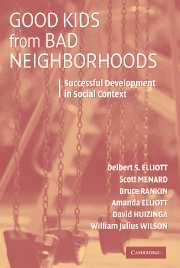Book contents
- Frontmatter
- Contents
- List of Tables and Figures
- Foreword by Richard Jessor
- Acknowledgments
- 1 Growing Up in Disadvantaged Neighborhoods
- 2 Growing Up in Denver and Chicago: The MacArthur Neighborhood Study
- 3 Good and Bad Neighborhoods for Raising Children
- 4 The Effects of Growing Up in a Bad Neighborhood: Initial Findings
- 5 Critical Dimensions of Neighborhood Organization and Culture
- 6 The Effects of Neighborhood Organization and Culture
- 7 Family Influences: Managing Disadvantage and Promoting Success
- 8 School Climate and Types of Peer Groups
- 9 What Matters Most for Successful Youth Development?
- 10 Successful Development in Disadvantaged Neighborhoods
- Appendix A
- Appendix B
- References
- Author Index
- Subject Index
8 - School Climate and Types of Peer Groups
Published online by Cambridge University Press: 06 August 2009
- Frontmatter
- Contents
- List of Tables and Figures
- Foreword by Richard Jessor
- Acknowledgments
- 1 Growing Up in Disadvantaged Neighborhoods
- 2 Growing Up in Denver and Chicago: The MacArthur Neighborhood Study
- 3 Good and Bad Neighborhoods for Raising Children
- 4 The Effects of Growing Up in a Bad Neighborhood: Initial Findings
- 5 Critical Dimensions of Neighborhood Organization and Culture
- 6 The Effects of Neighborhood Organization and Culture
- 7 Family Influences: Managing Disadvantage and Promoting Success
- 8 School Climate and Types of Peer Groups
- 9 What Matters Most for Successful Youth Development?
- 10 Successful Development in Disadvantaged Neighborhoods
- Appendix A
- Appendix B
- References
- Author Index
- Subject Index
Summary
SYNOPSIS
After early childhood, the school and the peer group begin to compete with the family and neighborhood as primary socializing contexts. Schools provide important training and opportunities for the development of both social and academic competencies. However, they are also contexts in which youth are exposed to different lifestyles, to drugs, violent or aggressive behavior of other students, and a new status system with its own unique performance demands. Good schools facilitate a successful course of development and bad schools undermine this type of success. The characteristics of the neighborhood immediately surrounding the school, the neighborhoods from which the school draws its students, and the characteristics of the families of those students, all combine to influence the school's social and academic environment. In this chapter, we identify two dimensions of the school context: the learning environment which we refer to as a Positive School Environment, and the level of safety or risk of violence in the school referred to as School Violence/Safety. Mechanisms linking features of the neighborhood and family contexts to the school environment and, in turn, characteristics of the school climate to successful developmental outcomes, are identified.
With the onset of puberty, the peer group emerges as the most influential interactional setting for patterns of adolescent behavior and an important influence on other dimensions of successful development. The neighborhood and the school are the two primary contexts in which peer groups are formed and interact, largely in response to characteristics of these two social settings.
- Type
- Chapter
- Information
- Good Kids from Bad NeighborhoodsSuccessful Development in Social Context, pp. 203 - 242Publisher: Cambridge University PressPrint publication year: 2006



